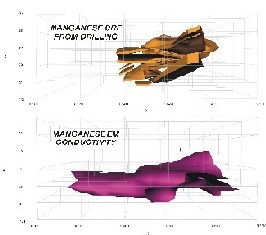2003 News Archive
Discovering manganese ore under cover using ‘hoistem’
Jayson Meyers - April 2003
LEME research has lead to the discovery of several new manganese
ore bodies in the Woodie Woodie manganese mine corridor, located
in the Pilbara region of Western Australia. The Woodie Woodie Mine
is owned and operated by Pilbara Manganese Limited, a subsidiary
of Consolidated Minerals Limited, who sponsored this project. High-grade
manganese ore is mined by Pilbara Manganese using open cut methods,
and the ore is shipped by truck to Port Headland for export around
the world where it is primarily used to make steel.
Manganese was discovered at Woodie Woodie over 50 years ago, and
has only been mined on a large scale by Pilbara Manganese over the
last five years. The geologists at Pilbara Manganese recently recognized
that the manganese ore is deposited from hydrothermal solutions
into ancient dolomite sedimentary layers that are 2.5 billion years
old. The ore deposits sit in fault and pipe like structures within
the dolomite, and they may not always come to the surface. Some
ore bodies are also buried by glacial sediments from the Permian
period, about 250 million years ago, and younger sedimentary deposits.
For these reasons, this project sits under LEME Program 2, Exploration
Under Cover.
 At
the recommendation of LEME researchers, an innovative time-domain
helicopter electromagnetic system called Hoistem was employed to
explore for buried manganese ore bodies previously missed by other
geophysical prospecting methods. The hoistem system is under development
by Newmont Mining and GPX Airborne, and was used at Woodie Woodie
as part of an ongoing R&D project run by Pilbara Manganese and
the Curtin University Exploration Geophysics Department in association
with the CRC-LEME. The Hoistem system works like a flying metal
detector that looks for conductivity changes in the ground, such
as conductive manganese ore in a resistive dolomite. At
the recommendation of LEME researchers, an innovative time-domain
helicopter electromagnetic system called Hoistem was employed to
explore for buried manganese ore bodies previously missed by other
geophysical prospecting methods. The hoistem system is under development
by Newmont Mining and GPX Airborne, and was used at Woodie Woodie
as part of an ongoing R&D project run by Pilbara Manganese and
the Curtin University Exploration Geophysics Department in association
with the CRC-LEME. The Hoistem system works like a flying metal
detector that looks for conductivity changes in the ground, such
as conductive manganese ore in a resistive dolomite.
 Following
supervision of logistics and parameter testing at site, the data
were processed by LEME researchers using innovative methods to enhance
the response of conductive manganese targets and to separate this
response from other conductive features, such as saline groundwater
and clay filled drainage valleys. A number of the targets were drilled
and about five new manganese prospects were discovered just within
the northern part of the Hoistem survey, with more targets to be
drilled occurring in the south. One of these ‘blind discoveries’
has turned out to be the largest single manganese ore body found
to date in the Woodie Woodie corridor, having a resource of 1.6
million tonnes. It sits under 20 metres of Permian clay and was
named ‘Chris D’ after a former company director (figures
1 and 2). Chris
D and other hoistem discoveries have increased Pilbara Manganese’s
resource base and extended the mine life by several years. Following
supervision of logistics and parameter testing at site, the data
were processed by LEME researchers using innovative methods to enhance
the response of conductive manganese targets and to separate this
response from other conductive features, such as saline groundwater
and clay filled drainage valleys. A number of the targets were drilled
and about five new manganese prospects were discovered just within
the northern part of the Hoistem survey, with more targets to be
drilled occurring in the south. One of these ‘blind discoveries’
has turned out to be the largest single manganese ore body found
to date in the Woodie Woodie corridor, having a resource of 1.6
million tonnes. It sits under 20 metres of Permian clay and was
named ‘Chris D’ after a former company director (figures
1 and 2). Chris
D and other hoistem discoveries have increased Pilbara Manganese’s
resource base and extended the mine life by several years.
Research is continuing on the geophysical nature of manganese mineralisation
and ore forming processes, and the application of innovative geophysical
methods for further exploration success. This project is supervised
by LEME researcher Dr. Jayson Meyers and LEME PhD scholarship recipient
Anousha Hashimi, both from Curtin University Exploration Geophysics.
|
